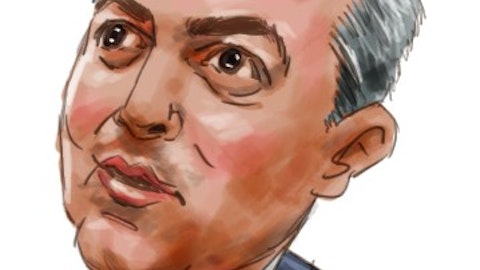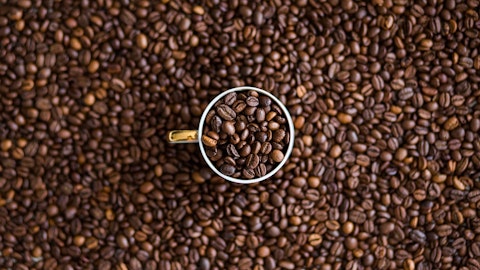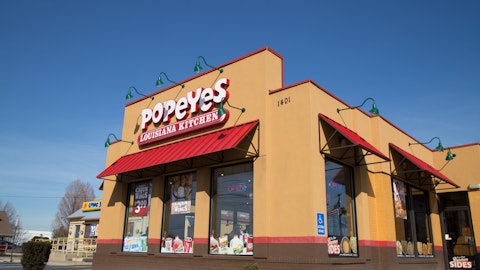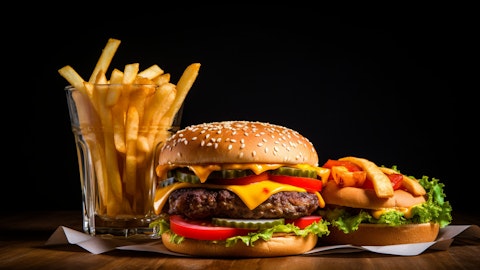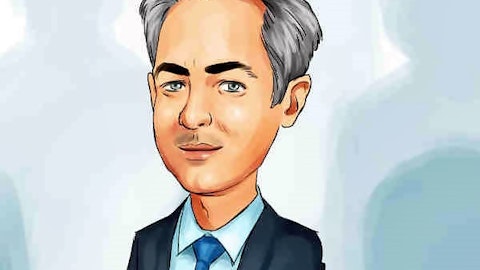Dennis Geiger: That’s a great point. Thanks, Matt.
Operator: The next question comes from Andrew Charles of TD Cowen. Please go ahead.
Andrew Charles: Great. Thank you. Josh or Patrick, I just hit the last question, maybe ask it a different way. Curious about your level of confidence of sustaining BK U.S. and Tims Canada traffic growth in 2024. And really specific to BK U.S. recognizing what could be an intensified value focus for the U.S. industry in 2024, suggested by your largest competitor? Thanks.
Joshua Kobza: Yes. Thanks, Andrew. I’ll share a couple of thoughts, Patrick, feel free to jump in as well. Like I said, I just think there’s so much stuff that Tom and team are doing that’s focused on the basics. That’s going to allow us to drive traffic, not just this year, but for many years to come. We’re improving our operations. We’re doing really cool things, focusing on our core equities, whether it’s the new commercials about it ain’t the same without the flame, focusing on the whopper with $1 million whopper, it’s a lot of stuff that’s going to create consumer excitement around our strongest core equities. I think that’s wonderful. And we’re also doing a lot more remodels. I mentioned we’re going to go from just over 250 remodels to 400 remodels.
Those are the kind of things that drive more customers into your stores, and we’re doing more and more of them and doing them really well. So that’s the stuff that I think gives us a lot of confidence in the outlook for this year and beyond. And at Tims, we’re – I think we noted, we’re now, I think, in year five of back to the basics and Axel and the team up there are doing a really nice job driving growth. They’re doing it through all the ways we’ve been talking about with PM food and cold beverage. And we have a pretty exciting pipeline of new innovations that are coming on those fronts in 2024 that I think are going to keep bringing our guests back even more often.
Patrick Doyle: Yes. I guess the only thing I’d add is, I mean, first, at Burger King, you’re just seeing more and more things that we’re getting done that are going to contribute to the growth. So more remodels coming on working through some of the tough situations with some franchisees, continued great advertising. And most importantly, franchisees getting more and more aligned and excited about the progress that we’re making in the brands. That increase in profitability is not only important in the absolute, but it’s important in the belief of our franchisees and what they’re going to be able to accomplish with the brand. So you can feel that momentum building around BK in the U.S. On the Tims side, this is, as Josh said, the continuation of returns from the investments that they made a number of years ago as they got everything right in that business.
I love that business. The team is leading it exceptionally well. The franchisees are doing well. Their profits being up the way they were, was terrific year-over-year. Still more progress to be made there, but just very, very excited about the strength of that brand and glad that I don’t have to compete with them. They are really good. They are really, really good in Canada, doing a lot of things right.
Operator: Thank you. Our next question comes from Chris Carril of RBC Capital Markets. Please go ahead.
Christopher Carril: Thanks. Good morning. So on the development outlook update that you provided, you highlighted the slower-than-expected China growth this year. Patrick and Josh, I know you touched on this briefly in your prepared remarks, but can you maybe expand a bit more on what or which markets you’re most confident will contribute to the acceleration in development this year even if it is a little bit lower than you previously thought?
Joshua Kobza: Yes. Thanks, Chris. So a few different things that I think are going to be helpful this year. And Patrick, I think, mentioned a few of them earlier, but I’ll give a quick recap as well. In terms of BK U.S., that’s definitely one of our focus areas. We had a bit more closures in 2023. Based on the incredible sales and improvements in profitability that Tom and the team have been driving, that gives us a lot of confidence that we’re going to be able to improve the unit trajectory there in a meaningful way this year. So that feels like it’s on track and move it in the right direction. The second big bucket is Firehouse. And there – we’ve talked a lot about some of the new development programs we’ve put in place.
We’re getting a lot of uptake on those and we’re starting to see the pipelines fill up and a lot of the sites moving through those pipelines. So I’m pretty confident we’re going to see a meaningful step-up in the Firehouse development, both in the U.S. and Canada. We had some incredible openings out in Western Canada in Q4. And I think there’s a lot of excitement for the brand across Canada. So those two things feel like they’re moving in the right direction. We’ve got some good stuff happening in International across our new brands, especially some of the stuff that we’re doing with Popeyes and Tims. We have some of the Popeyes markets that are ramping up. Think of places like Popeyes in India or Popeyes in the U.K. There are a number of those markets, Popeyes in France is another great one.
We were there just a few months ago, and they’re doing a really nice job. So there’s a lot of good Popeyes markets that are ramping up, and I think we’ll see some positive momentum on in 2024. The other side of that, obviously, is what’s going on in China. And I think there’s a – there are a couple of factors that are going in there. One, we’ve seen a continued shift to some of these smaller express units within Tims that as we mentioned, we don’t count in our restaurant count. So that has some impact on the KPI. And we also do believe that there needs to be some more capital put into that business to really realize its potential. And then on BK China, you probably saw – we actually did see a step forward in 2023. We were up to around 176, I think, net new units for the year.
But I think there is some question on the outlook and kind of appetite and alignment for growth there. That’s impacting our outlook for the full-year. So that’s sort of the puts and takes of it, which, as we said, we think gets us to around 4.5%. And we’ll keep updating you throughout the year as we get more visibility into where that’s likely to land.
Patrick Doyle: The only thing I’d add is, look, we’ve got longer-term confidence in net unit growth. We really do. This is simply about China and how much capital is available to grow near term this year. All of the rest of the things that we have looked at that are going to generate unit growth are very, very much on track.
Operator: Our next question comes from Brian Harbour of Morgan Stanley. Please go ahead. Your line is open.
Brian Harbour: Yes. Thank you. Good morning. In Burger King U.S. in the fourth quarter, how much do you think – I know there’s a number of initiatives that are working very well. How much of that, though, do you think was a consequence of the marketing you did? Also, do you think that kind of the marketing investment in 2024 will look similar with respect to timing? Or what else do you think was sort of a swing factor there in the fourth quarter?
Joshua Kobza: Hey, Brian. Good morning. So in terms of BK U.S. in the fourth quarter, it’s hard to quantify the exact breakdown, but I do think there was a positive impact from the advertising spend for sure. We’re investing more. And I think the team is doing a wonderful job on the effectiveness of that advertising. But I also think there’s a big impact there from operations. It’s one of the things that’s underappreciated, but we’re seeing a big improvement in the quality of operations and our franchisees are doing a fantastic job there. And we think that’s a big part of the overall comps for the year. Potentially up to about half of the comps for the year, we think could be due to operational improvements. So I’d say that’s the other largest factor in our mind.
In terms of the 2024 outlook, as we mentioned in our earlier remarks, we’re about caught up in terms of where you’d expect us to be in terms of that advertising spend in the program to date. So I think we have just under $60 million left to spend in 2024. We’re probably – we’re not ready to give an exact pacing of that throughout the quarters quite yet, but I would hope it will be a little bit more even than what we saw in 2023.
Operator: The next question is from Sara Senatore of Bank of America. Your line is open.
Sara Senatore: Great. Thank you. I just wanted to ask about just a point of clarification and then a quick question. I’ll start with the question first. So you talked about positive traffic in the – at Burger King, and I wanted to dig in there a little bit. Because you did close stores this year and historically, what we’ve seen is that store closures do tend to benefit the system in terms of positive comps. So I’m trying to understand as we think through kind of that balance of unit closures versus positive traffic in the remaining stores. If you saw any benefit from that sales transfer or closing lower-performing stores? So that was one question. And then just quickly the clarification was on China. You said you’re working with your Tims and Burger King partners to encourage growth. But what does that mean exactly if you’re not planning on committing capital as you are in the U.S.?
Joshua Kobza: Yes. Sara, thanks for the questions. On the first one, in terms of traffic, a couple of comments I would just make there. If you look at the sequencing through the year, we had been taking some closures throughout the year. And so while there may be some positive impact to that, we don’t see it super clearly. And I think what’s most striking to me at least is – we saw that very consistent movement in a pretty pronounced way in terms of the trajectory of our traffic, right? We went from a pretty negative place up to low single digits negative, flat and then quite improved kind of positive low single digits in Q4. So I think that traffic improvement is really outpacing anything you’d expect to see related to the pace of closures there.
And then on China, we kind of talk through some of the factors there. We’re definitely working closely with our partners. We obviously have, as I mentioned, we have really big ambitions for what we think we should do in the market and what we think our brands can accomplish. There are a lot of different ways that we work with our partners on that related to operations and profitability and capital. And we’re working through all those different options with them. We don’t have anything more to share on it quite yet today, but we’ll bring anything back as soon as we do.
Operator: Next, we have Brian Mullan of Piper Sandler. Please go ahead.
Brian Mullan: Thank you. Just a question on Popeyes specific to the U.S. Can you just update us on the simplifying the operations journey that you’re on? Maybe touch on what the key priorities are for 2024 as a part of the plan? And related – I asked because the unit growth is very solid already at 4.5% last year. But is the thought that you’d actually be able to accelerate that unit growth pace once more and more operational improvements are made?
Joshua Kobza: Thanks, Brian. So in terms of where we are on improving operations, especially around what we’ve called our easy-to-run kitchens. So throughout 2023, we were focused on improving the model, kind of making sure we had the right combination of elements in that easy-to-run kitchen, whether that’s software improvements or new pieces of equipment, new procedures, new technology. And I think we’ve got that increasingly well refined through those early pilot restaurants. What we’re working on now is starting to ramp up deployment in clusters. So one of the ones that I mentioned is out in California. That’s been one of the first places that we’ve got a lot of interest from franchisees. So we’re going to go and do like a larger deployment in the cluster in California, and then we’ll start to do a few more of those throughout the course of 2024.
